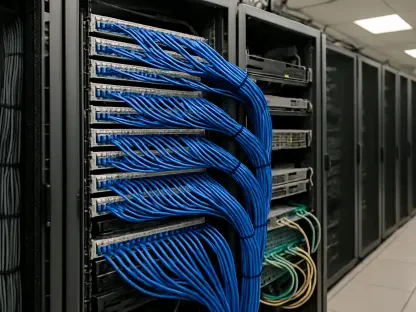The rapid integration of Internet of Things (IoT) devices into healthcare has revolutionized how medical care is delivered, offering real-time monitoring, seamless data sharing, and enhanced decision-making capabilities for providers across the globe. From MRI machines to infusion pumps, over one million of these connected devices are now integral to patient care, managing sensitive information like medical scans and personal health records. Yet, this technological leap forward casts a long shadow, as alarming vulnerabilities expose these systems to devastating cyberattacks. With cybersecurity scans revealing that more than 1.2 million healthcare IoT devices are at risk worldwide, the safety of these innovations is under intense scrutiny. This pressing issue uncovers a critical blind spot in modern medicine, where the very tools designed to save lives could become instruments of harm if not properly secured against global threats.
Unveiling the Scope of the Crisis
Exposure on a Global Scale
The magnitude of the vulnerability in healthcare IoT systems is staggering, with the United States bearing the brunt of the exposure, accounting for over 500,000 at-risk devices. Other nations, including South Africa and Australia, are also grappling with significant numbers of unsecured systems, painting a truly global picture of concern. Advanced scanning tools from cybersecurity firms like Modat have pinpointed that many of these devices are accessible online due to basic security oversights, such as unchanged default passwords and failure to update software. This widespread issue isn’t confined to a single region or type of equipment; it spans across various critical tools essential for patient care. The lack of robust defenses means that hackers could potentially access sensitive data or disrupt medical operations on an unprecedented scale, raising alarms about the readiness of healthcare systems to counter such threats in an increasingly connected world.
Root Causes Behind the Weaknesses
Delving deeper into the reasons for this vulnerability, outdated protocols like DICOM, commonly used for medical imaging, often lack modern encryption, leaving patient data such as X-rays and personal histories exposed through open ports. This technological lag is compounded by a systemic tendency to prioritize connectivity and efficiency over stringent security measures. Many healthcare facilities, especially in the U.S., operate with legacy systems that are not easily compatible with current cybersecurity standards, creating a patchwork of defenses that are easily breached. The failure to implement routine patches or adopt secure configurations further exacerbates the problem, turning these life-saving devices into potential entry points for malicious actors. Addressing these root causes requires not just technical upgrades but a fundamental shift in how security is perceived and prioritized within the healthcare sector.
Exploring the Consequences and Challenges
The Human and Financial Toll
The implications of unsecured healthcare IoT devices extend far beyond mere data breaches, striking at the very heart of patient safety with chilling possibilities. Hackers gaining access to devices like infusion pumps could manipulate settings to deliver incorrect drug dosages, potentially leading to life-threatening outcomes for unsuspecting patients. Similarly, wearables that monitor vital signs might be tampered with to display false readings, misleading medical staff in critical situations. Beyond physical harm, the theft of personal data opens the door to identity fraud and medical scams, eroding trust in healthcare providers. With industry surveys indicating that 75% of these devices harbor vulnerabilities, and considering the sector generates 30% of global data, the scale of potential damage is immense. The human cost, paired with financial burdens from legal settlements, underscores the urgent need for stronger protective measures.
Historical Patterns and Ongoing Risks
Looking at historical incidents provides a sobering reminder that the current crisis is part of a long-standing pattern of neglect in securing connected medical systems. Breaches as far back as 2023, which compromised millions of patient records through IoT endpoints, mirror today’s challenges, showing little progress in closing security gaps. Major incidents like the Ascension breach, affecting 5.6 million patients, reveal how deeply entrenched these issues are, particularly among U.S. providers. Social media platforms like X are abuzz with public outcry over exposed MRI data and leaked mental health records, reflecting widespread frustration with systemic failures. Reports from sources like HIPAA Guide note that over 31 million Americans were impacted by data breaches in just the first half of this year, highlighting an escalating trend despite fewer overall incidents. These persistent risks signal that without immediate intervention, the healthcare sector remains a prime target for cyber exploitation.
Pathways to a Secure Future
Bridging the Gap Between Innovation and Protection
Despite the daunting challenges, there is a glimmer of hope in the growing healthcare IoT security market, which is projected to reach $3.52 billion by 2034 with an annual growth rate of nearly 19%. This surge, fueled by the rise of telemedicine, indicates a recognition of the need for better defenses. However, the gap between investment and actual implementation remains wide, as legacy systems in many hospitals are incompatible with modern cloud-based security upgrades. Regulatory efforts, such as GDPR fines in Europe, aim to enforce compliance, but adherence is inconsistent across regions and institutions. Solutions like AI-driven anomaly detection and zero-trust architectures have been proposed as effective ways to bolster defenses, yet their adoption is slow. Bridging this divide requires not only financial commitment but also a concerted effort to integrate security into the design and deployment of every connected device in healthcare settings.
Fostering a Security-First Mindset
Ultimately, the most significant barrier to securing healthcare IoT devices lies in cultural attitudes within the industry, where these tools are often seen as efficiency enhancers rather than potential liabilities. Shifting this perception demands a security-first mindset, where every device is treated as a possible point of attack that must be rigorously protected. Experts emphasize the importance of regular penetration testing, firmware updates, and network segmentation to mitigate risks, while social media discussions on platforms like X amplify the call for accountability following breaches impacting millions. High-profile cases, such as the Episource incident affecting 5.4 million users, have led to costly settlements, serving as stark reminders of the stakes involved. Encouragingly, upcoming regulations anticipated by 2026 may mandate certification for IoT devices, pushing the industry toward proactive measures. Reflecting on past failures, the focus must now shift to actionable steps that prioritize patient safety and data integrity above all.









